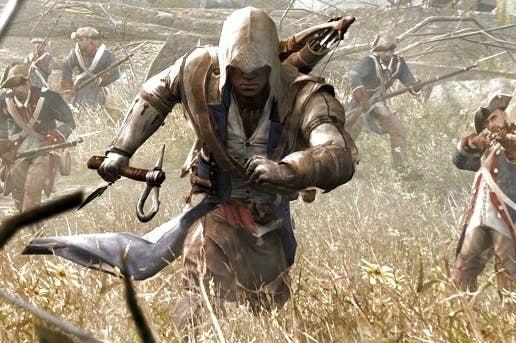Face-Off: Assassin's Creed 3 on Wii U
The launch game stacked up against Xbox 360, PS3 and the new PC version too.
For our original Assassin's Creed 3 Face Off, we were pleased to find the game's visuals on both 360 and PS3 were very closely aligned indeed, and welcomed the addition of v-sync to a series with a long-standing reputation for intrusive screen-tearing. Frame-rate issues were a factor around the busy Boston and New York areas, but it still stood as a respectable release for developer Ubisoft Montreal, marking the fifth game in the series for the two trusty home consoles.
Now we have the Wii U version to add to the collection, released just a day after the console's European launch. Despite Nintendo's dogged efforts to keep the console's raw hardware specs veiled, the recent revelation that its three CPU cores are clocked to a modest 1.24GHz value does put the lacking performance of some multi-platform releases such as Batman: Arkham City into perspective. It's perhaps an example of how tasks traditionally assigned to the processor such as AI routines, physics and in-game animation systems can potentially be the performance pitfall if not accommodated carefully - a growing pain usually associated with new hardware, and one that will hopefully disappear with more development time.
So let's see how Assassin's Creed 3 fares in the company of other such launch-window titles, and assess whether the GamePad features amount to anything substantive enough to give the Wii U version an edge. To start, we run through an image quality comparison via our suite of head-to-head videos, plus a quad-format comparison gallery. This now includes the recent PC release, which comes complete with DirectX 11 features such as tessellation - producing superior bump mapping and smoother character models - and the alluring promise of quadruple resolution textures.
It's a great turnout for the Wii U from the off, with a native resolution that matches the 1280x720 output on 360's and PS3's (with Sony's platform stripping just two pixels from the top). It also offers up a direct match for Ubisoft's post-process anti-aliasing method on those two consoles, which is equivalent to the standard quality AA setting on PC.
For the sake of preserving texture clarity in our captures, we prefer this default setting on PC to the more aggressive very high setting; alas, residual blurring becomes more apparent the higher you go. Treatment of fine 2D detail, such as trees or ropes around ships, is far more thorough if the Kepler-exclusive TXAA option is enabled, though once again this softer approach doesn't flatter the image in still frames.
"Almost down to the pixel, the Wii U version is an extremely close match for both the Xbox 360 and PlayStation 3 versions."
Alternative comparisons:
Returning to Wii U, we're pleasantly surprised at how closely all assets match up to its 360 and PS3 counterparts; textures are identical, dithered self-shadowing is still in effect, and level of detail (LOD) settings appear the same. This is made especially clear when synchronising at the top of buildings, where the ensuing panoramic shots allow you to see which parts of the world are being rendered from a distance. Save for the randomised NPCs, all geometric elements appear identical across the console platforms - it's only once you switch to the superior PC version that you see the trees, rooftop details and shadows actually missing from the scene.
Down at ground level, the egregious shadow pop-in of the 360 and PS3 versions is also an apparent feature on Nintendo's new platform when travelling quickly around towns. We also see triangle culling too, which causes a flickering effect on the cargo around Boston harbour on approach. In this case, more polygons are utilised to flesh out environmental details depending on your proximity to them; a RAM and performance-saving technique that happens to play out quite visibly. Foliage rises from the ground when running across grassy terrain, and NPCs also uphold their habit of appearing in front of you abruptly (and sometimes vanishing outright). It's the same situation regardless of which console version you choose, and by comparison, the PC version isn't shaken by any of these immersion-breakers.





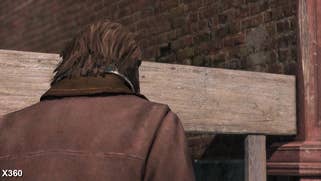
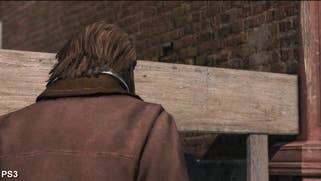
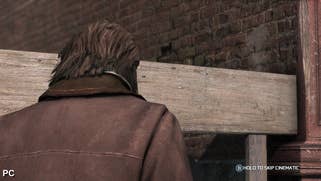
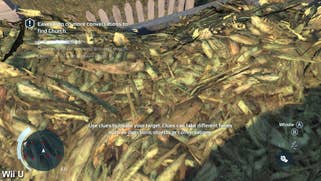


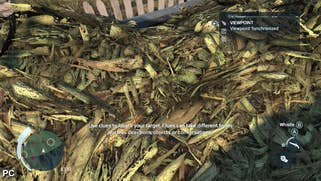

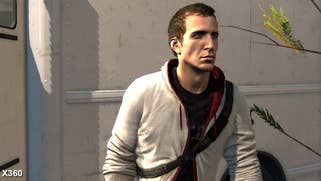


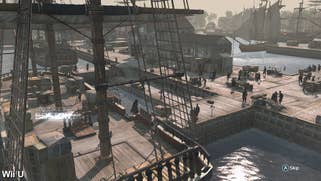



In fact, the Wii U's faithful delivery of Assassin's Creed 3 extends to the game's list of glitches. Even on patch v1.01, weighing in at 65mb, General Braddock's lips still don't move during part of his angry introductory speech - an uncanny moment in line with the other versions on their original playthroughs. Thankfully, we notice this appears to have been solved for the PC release. We also spot an intensified depth-of-field effect on Wii U (pictured above), which overlaps onto the characters in focus at the time, likely counting as a glitch in its implementation.
Outside of this one issue, there's nothing to distinguish the game's visual make-up from the 360 and PS3 editions, meaning our next port of call is the use of the GamePad's touch-screen. As with its integration in Black Ops 2, we see the extra space being used to show an enlarged version of the map during gameplay, while cut-scenes simply mirror the HDTV's output. It's a rudimentary effort, but happens to be more practical in a game such as this, where your eyes needn't be glued to the screen all the time. It's a slower-paced game involving plenty of travel, and the range of the map is widened enough to help highlight a possible route through the sprawling frontier areas.
Actual touch-screen interaction is very limited here. At its most useful, we can whistle for our horse by tapping a virtual hotkey to the top-right, which spares us the menu-digging needed to achieve the same result in other versions. It's a shame this isn't taken one step further by allowing you to switch between tools and weapons through icons permanently mapped to the touch-screen. Instead, the process involves holding down the R button to switch to the specific menu as usual, which also causes gameplay to stop on the main screen. A direct, on-the-fly approach could have been possible here, and we hope something akin to it shows up in the studio's next game.
"Quad resolution textures add a great deal to the PC experience - there's the raw detail there to make the game shine at 1080p."


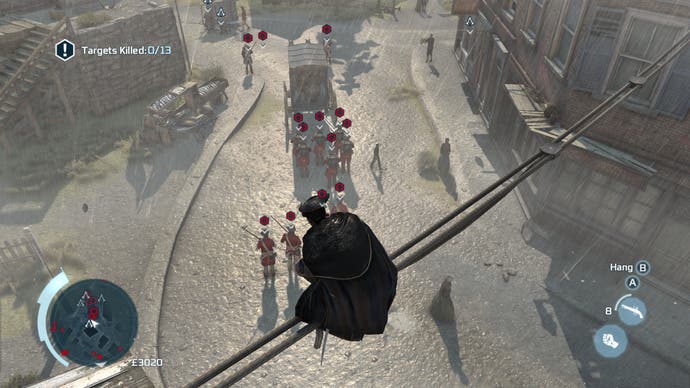
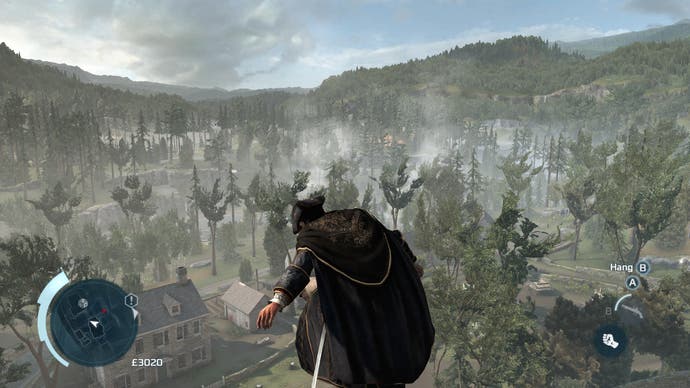
A remote play option is also available in the game's menus, which, once selected, allows play to carry on solely on the GamePad screen. This sets an impressive precedent for handheld gaming, though we find the compression algorithm used to stream the image across can break up certain flourishes of high detail in outdoor sections. This is where Nintendo's use of bright, clear colours in games like New Super Mario Bros. U reveals an advantage; the colour palette of Assassin's Creed 3 arrives slightly muted and grey, and some of the fine edging around tree branches can appear fuzzy for the moments following quick camera pans. It's a worthwhile feature that truly carries the broad scope of the game to the small screen, but it's sometimes best to not look too closely.
Speaking of extra features, the PC version arrives with some tangible benefits of its own. A bump to texture resolution is obvious around the world itself, from the wood-grain on fences to the cracked paintwork around New York's shop entrances. It's a richer looking game as a result, though curiously, clothing on major characters remains largely unchanged outside of a sharpening to Haytham's necktie, or the embroidery to Franklin Roosevelt's waistcoat. It's safe to assume Ubisoft Montreal intended to avoid making any major cuts to visual quality on characters themselves for the console releases, being such a regular fixture of the experience.
Assassin's Creed 3: performance analysis
So let's shift over to performance issues. It's been satisfying to see the progress of the series come to a head during our original Assassin's Creed 3 analysis, where we found the PS3 and 360 versions finally running with full v-sync, albeit without a specific frame-rate cap. Having proven it boasts like-for-like image quality, plus the added perk of GamePad controls, our hopes are pinned on the Wii U to at least match the competition's set-up here. To test this, we start with a few clips of synchronised footage consisting of cut-scenes, mixed in with clips of our lead character walking directly forward through a level.
Excluding a few scenes, such as Haytham writing alone in his cabin, the frame-rates for all three platforms tend to stick close together, wherever they may travel. We see equivalent dips down to 20FPS while doing a leap of faith, for example, likely as a result of new geometry and NPCs quickly streaming in as the character zooms to the cart below. It's a respectable turnout for the console, but on average the Wii U does appear to drop frames at a slightly higher rate than the other platforms.
"Assassin's Creed 3 runs with v-sync engaged along with an uncapped frame-rate - just like the existing Xbox 360 and PS3 releases."
We do see v-sync firmly engaged, ensuring each frame being rendered arrives in its complete form, rather than tearing midway through when the console is taxed too heavily. True to the spirit of the 360 and PS3 releases, there's no real adherence to a 30FPS cap here either, despite being the ideal target in this game's case.
To push the platforms a little harder, we put more demanding battle and city traversal scenes up to close scrutiny. In practise, it appears there are a few optimisation issues on Wii U that leave it worse for wear while running through busy areas, such as the Boston market. We see it linger around the 25FPS point for long stretches of play here while the other versions hold out at an ideal 30FPS - though all three suffer to the same 20FPS extreme during the many battles with red-coated guards. It's playable, but the 360 takes a lead in these areas overall, with the PS3 coming in a close second
Regarding PC performance, running the game maxed out at 1080p with 60FPS feedback is easily possible for our enthusiast-spec PC: a i5-2500k CPU matched with 8GB of 1600MHz RAM and an Nvidia GTX 670. However, there are difficulties playing at the highest environment quality setting around the Boston harbours, which drags the frame-rate down to 45FPS intermittently as we run through the crowds. Perfect playback is reclaimed once we lower this setting to just high - an easy fix, causing the geometry and NPCs to draw in at a slightly closer range, though never to the same noticeable degree as on consoles.
"In the more graphically demanding areas of the game, the Wii U version does run with a noticeable frame-rate deficit compared to the other console versions."
Assassin's Creed 3 on Wii U: the Digital Foundry verdict
With all four versions of Ubisoft's trilogy-closer out in the wild, the Wii U certainly stands its ground against the PS3 and 360 releases. Besides a broken depth of field effect that crops up during several cut-scenes, the look of the game is nigh on identical in terms of native resolution, texture quality, its shadow rendering method, and environmental detail. Even down to the shimmering of the ambient occlusion effect beneath fields of grass, and the odd dialogue glitches that appear in the other console versions, Nintendo's hardware certainly delivers a very faithful take on the experience.
That is, at least on a visual level. The use of the GamePad as a dedicated map screen doesn't strike us as a masterstroke in game design, but it's a useful addition that lets players goggle over a wider cross-section of the world without resorting to the select button. There are plenty of avenues that could be explored here, including the idea of creating virtual hot-keys for the most-used abilities and weapons - something hinted at in passing with a single button assigned for summoning a steed.
As an optional extra, the ability to remote play a blockbuster console release purely on a handheld does give the Wii U version a slight edge over the competition. It's only unfortunate that the frame-rate doesn't quite hold as steady compared to the 360 rendition, being more in the ballpark of the PS3 when chasing down the city streets, and marginally lower during some cut-scenes. This makes it the weakest of the trio in the crucial performance stakes, though they all have issues in achieving a sustained 30FPS where it's needed.
Ubisoft seems to be in an uncompromising mindset with its two juggernaut releases this year, having also had Far Cry 3 push these platforms to unflattering levels of performance in order to squeeze out the best visuals possible. If you can't stomach playing games at circa 25FPS, then the PC version really is the recommended way to play Assassin's Creed 3, not least to enjoy of the bevy of huge graphical upgrades it also comes packaged with. But, if you're happy to take those frame-rate knocks on the chin, and simply want a new Wii U game to play while someone occupies the HDTV, then this is undoubtedly one for the short list.
